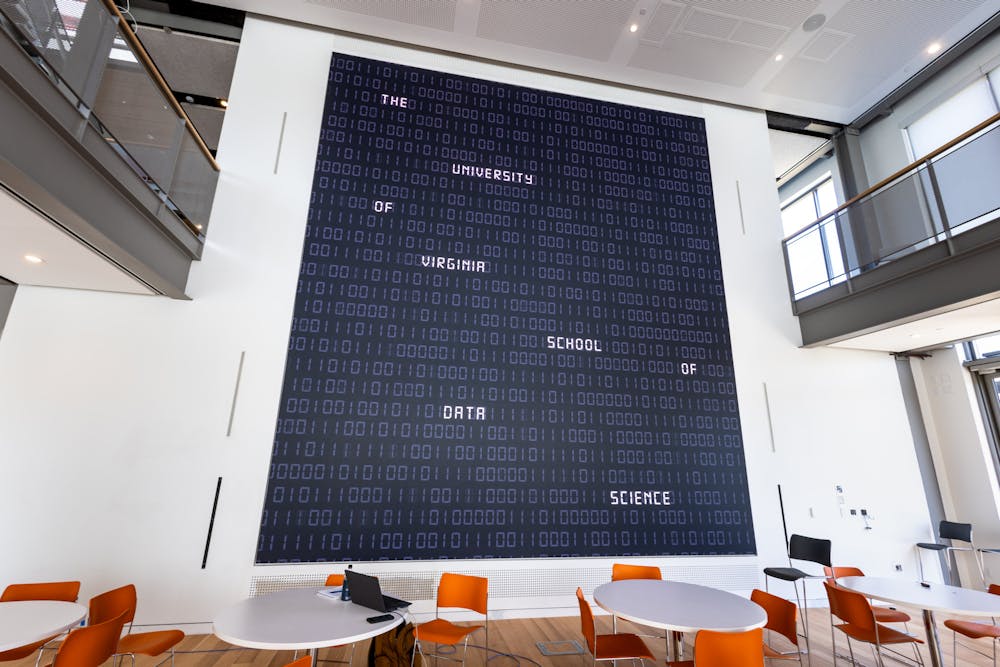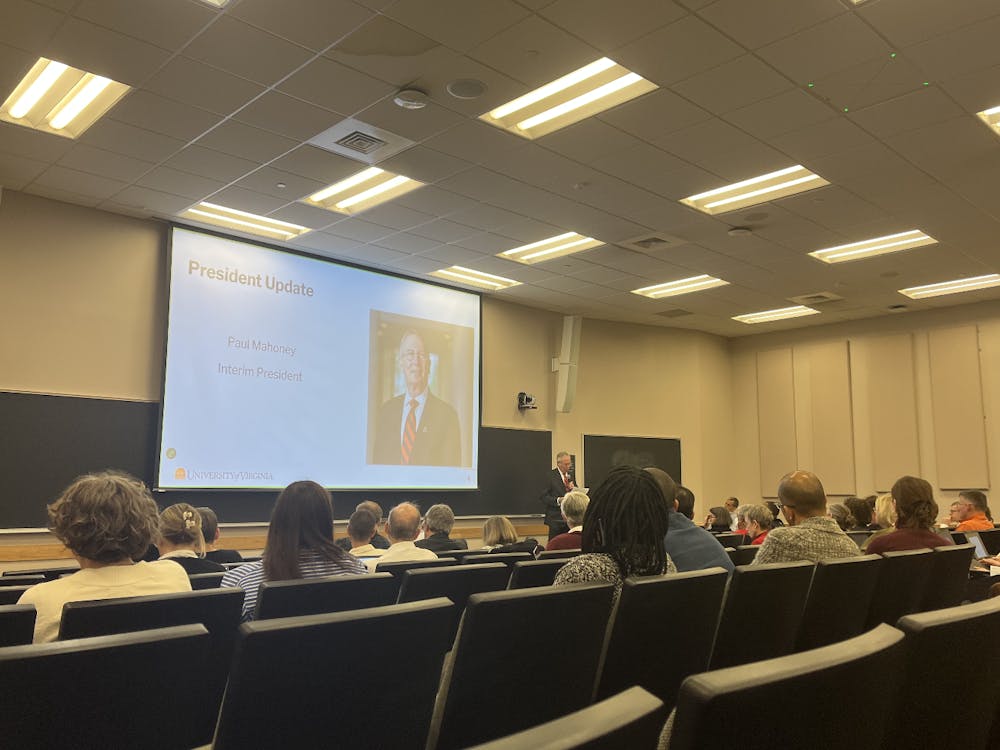With new classrooms, student research areas and sustainability-focused architecture, the new School of Data Science building will not only serve data science students and faculty, but act as a hub for interdisciplinary collaboration and research at the University. The SDS works to live up to its nickname as “a school without walls” through both the building’s open layout and the curriculum’s goal of promoting research and collaboration across disciplines.
The new SDS building spans approximately 60,000 square feet and rises four stories high. It features four classrooms, two with 75-person capacities and two with 45-person capacities. The building also features two seminar rooms distributed across three levels, and both the classrooms and seminar rooms contain flexible furniture arrangements conducive to group work. The SDS spaces are also transparent, with faculty offices and study spaces close in proximity to each other and surrounded by large glass windows.
The School of Data Science building is located on the Ivy Corridor, a University-owned parcel of land that spans approximately 14.5 acres at the intersection of Emmet Street and Ivy Road. The University Foundation — an organization responsible for expanding large real-estate developments at the University — states that the project timeline began in 1992. The grant to support the SDS establishment was provided by the Quantitative Foundation — a private foundation based in Charlottesville and led by Jaffray Woodriff, trustee and class of 1991 alumnus.
According to Emma Candelier, director of communications for the SDS, the building will open its doors and classroom spaces to students studying within the data science major in the Fall 2024 semester, hosting an inaugural cohort of 75 students.
Candelier said that the building provides a distinct collaborative space to data science students for the first time. Previously, data science courses were spread across Grounds in various locations, such as the Dell buildings and the School of Education. Candelier said that the SDS building now provides a hub for students to exchange ideas and research together, serving as the first home-base for data science students.
“It is [now] a physical embodiment of a school that was an institute,” Candelier said. “[We have] an actual physical space to say, this is our home, this is where we teach, this is where we learn [and] this is where we research together … I think that's really important.”
The data science major, approved in March 2023, requires students to complete 120 credit hours over the span of three years. The major program currently has a cap of 75 students per cohort, which does not include students pursuing a data science minor. All the core classes required for the B.S. in Data Science major will be held in the SDS building beginning Fall 2024, with the possible exception of certain introductory classes, which may be held in other buildings depending on their size. However, the almost 800 students enrolled in the data science minor — introduced in July 2020 — will continue attending classes outside the physical SDS building due to space constraints. Despite these limitations, Candelier said that all students are welcome in the SDS space, regardless of their academic pathway.
The SDS building itself is also geared towards interdisciplinary collaboration. Referred to as the “nexus of discovery” within the Ivy Corridor, the SDS currently engages in five domains of interdisciplinary research, according to its website — health and medicine, environment and architecture, governance policy and society, education and research development and science and computation. Arlyn Burgess, associate dean of administration for the SDS, said that opportunities for cross-discipline work are not limited, but instead encouraged, as data science is propelled by the need for discovery in other fields.
“We see ourselves as a school that doesn't want to be constrained,” Burgess said. “The idea of school without walls is removing limitations to the ways that we can grow and develop as we see what the future of data science holds.”
Beyond the open and transparent layout, the building also works to advance environmental sustainability — features such as ample natural lighting, openable windows that naturally ventilate, solar panels and an automated energy system are designed to promote green energy use long-term.
The SDS has previously committed itself to sustainability, in line with the University's aim of reaching carbon neutrality by 2030. Burgess said that the building hosts 159 solar panels, generating approximately 70,000 kilowatt hours of clean energy.
To manage day-to-day energy consumption, however, the SDS will collect data on its own usage. The building’s energy system, facilitated by a Building Automation System, tracks energy consumption through sensors monitoring lighting, heating and other factors. The BAS also optimizes energy usage by deactivating HVAC systems in unoccupied areas of the building. Burgess emphasized that these data-driven metrics not only promote sustainability but also offer opportunities for students and faculty to analyze new data.
“The building automation system was made to be sophisticated so that it could actually respond to the [energy] data,” Burgess said. “The building [is] a living laboratory, where faculty and students can actually get access to the data about the building and help create initiatives to nudge behavior to better utilize the building [and] create better energy usage.”
Though the SDS building offers a new space for collaboration, current faculty and staff numbers have grown significantly since the building's planning stage. Burgess said that when the SDS building project first began in 2019, there were 16 staff and five faculty members, compared to the school’s 53 staff members and 55 faculty members today. Burgess said that the SDS may have to shift the building’s space usage in the future to accommodate the growth of the SDS, which can be made possible through the flexible and open layout of the SDS building.
“While we don't have a lot of extra room here, for the next 10 years of growth, we do feel like we've created a very flexible framework and a very beautiful space,” Burgess said.
Construction is underway for other buildings in the Ivy Corridor, housing various facilities and institutes like the Karsh Institute of Democracy — a University organization dedicated to preserving democracy through civic engagement. Additionally, a $50 million performing and visual arts center will provide venues for music and art, and a hotel and conference center known as the Virginia Guesthouse will create additional space for those visiting Grounds. The corridor will serve as a bridge between North Grounds, Arts Grounds and Central Grounds.
The opening celebration and ribbon cutting ceremony for the SDS will take place April 26, and the building will officially open to the public May 8. Faculty and staff will move into the building after the end of the Spring 2024 semester.







